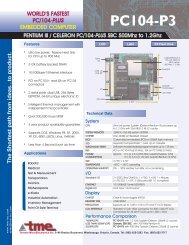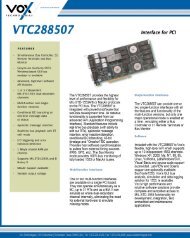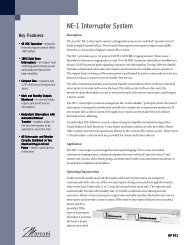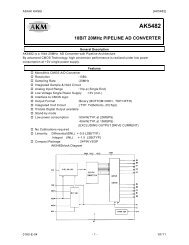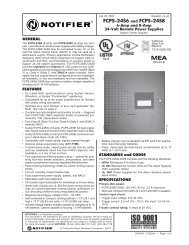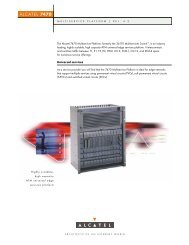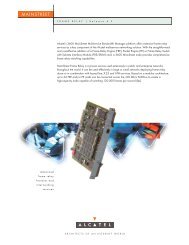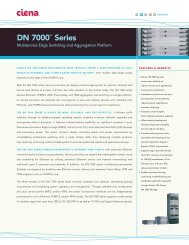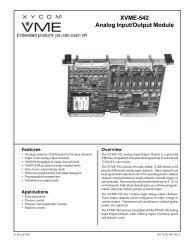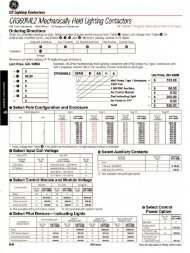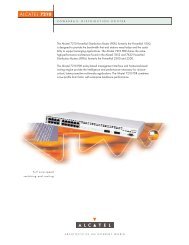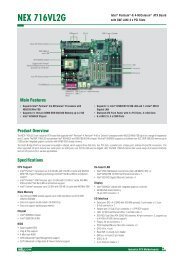Datasheet - VoxTechnologies
Datasheet - VoxTechnologies
Datasheet - VoxTechnologies
Create successful ePaper yourself
Turn your PDF publications into a flip-book with our unique Google optimized e-Paper software.
ROCKY – 548TXPentiumSBC@Copyright 1997All Rights Reserved.Manual second edition Oct..1,1997The information in this document is subject to change without prior notice inorder to improve reliability, design and function and does not represent acommitment on the part of the manufacturer.In no event will the manufacturer be liable for direct, indirect, special,incidental, or consequential damages arising out of the use or inability to usethe product or documentation, even if advised of the possibility of suchdamages.This document contains proprietary information protected by copyright. Allrights are reserved. No part of this manual may be reproduced by anymechanical, electronic, or other means in any form without prior writtenpermission of the manufacturer.TrademarksROCKY-548TX is registered trademarks of Acquire Inc.,IBM PC is aregistered trademark of International Business Machines Corporation. Intel isa registered trademark of Intel Corporation. AMI is registered trademarks ofAmerican Megatrends, Inc. Other product names mentioned herein are usedfor identification purposes only and may be trademarks and/or registeredtrademarks of their respective companies.
Contents1. Introduction .......................................................... 31.1 Specifications ..............................................................................41.2 What You Have ...........................................................................52. Installation ............................................................ 62.1 ROCKY-548TX's Layout ..............................................................62.2 Unpacking ...................................................................................82.3 Setting the CPU of ROCKY-548TX.............................................. 92.4 System Memory DRAM.............................................................. 112.5 Watch-Dog Timer ...................................................................... 122.6 DiskOnChipFlash Disk ............................................................ 122.7 Clear CMOS Setup .................................................................... 142.8 Battery Backup for CMOS Setup ............................................... 143. Connection......................................................... 153.1 Floppy Disk Drive Connector...................................................... 153.2 PCI E-IDE Disk Drive Connector ................................................ 163.3 Parallel Port............................................................................... 173.4 Serial Ports................................................................................ 173.5 Keyboard Connector .................................................................. 181
3.6 External Switches and Indicators ............................................... 183.7 External Speaker ....................................................................... 193.8 PS/2 Mouse 6-Pin Mini-DIN Connector ...................................... 193.9 External Battery Connector ....................................................... 203.10 USB Port Connector .................................................................. 203.11 IrDA Infrared Interface Port ....................................................... 203.12 Fan Connector .......................................................................... 213.13 Chassis Open Alarm Connector ................................................ 223.14 +5V Standby Connector for ATX Power Supply ......................... 223.15 ATX Power Switch / Soft Power Switch Connector ..................... 234. AMI BIOS Setup................................................. 244.1 Getting Start .............................................................................. 244.2 Standard CMOS Setup .............................................................. 254.3 Advanced CMOS Setup ............................................................. 264.4 Advanced Chipset Setup............................................................ 274.5 Peripheral Setup ....................................................................... 284.6 Power Management Setup ......................................................... 294.7 PCI / PLUG AND PLAY Setup.................................................... 304.8 Hardware Monitor Setup ……………………………………………315. E 2 Key Function .................................................. 32Appendix A. Watch-Dog Timer .............................. 342
1IntroductionWelcome to the ROCKY-548TX PentiumSingle BoardComputer. The ROCKY-548TX board is an ISA/PCI form factorboard, which comes equipped with high performance PentiumCPU and advanced high performance multi-mode I/O, designedfor the system manufacturers, integrators, or VARs that want toprovide all the performance, reliability, and quality at areasonable price.This board built-in DiskOnChip(DOC) Flash Disk for embeddedapplication. The DOC Flash Disk is 100% compatible to harddisk. User can use any DOS command without any extrasoftware utility. The DOC currently is available from 2MB to72MB. There also have PROMDISK-Chipcan be used in thesame DOC socket as an alternative solution.An advanced high performance super AT I/O chip – WinbondW83977TF is used in the ROCKY-548TX board. Both on-chipUARTs are compatible with the NS16C550. The parallel port andIDE interface are compatible with IBM PC/AT and XTarchitecture's.In addition, the ROCKY-548TX provides four 72-pin SIMMsockets and one 168-pin DIMM socket for its on-board DRAM.The RAM module accepts 1MB, 2MB, 4MB, 8MB, 16MB, 32MB,And 64MB. So,the total on-board memory can be configuredfrom 2MB to 256MB.ROCKY-548TX uses the advanced INTEL Chipset,430TXwhich is 100% ISA/PCI compatible chipset.with PCI 2.1standard.1.1 Specifications :3
The ROCKY-548TX Pentium Single Board Computer provides thefollowing specification:• CPU : Pentium/MMX up to 233Mhz, AMD K5/K6 processor,Cyrix 6x86 processor• Bus : ISA bus and PCI 32-bit local bus,PCI 2.1 standard• DMA channels : 7• Interrupt levels : 15• Chipset : Intel 430TX• Real-time clock/calendar : in 430TX chipset, backup by industrialLi-battery,3V/850mAH. .• RAM memory : 2MB to 256MB,SDRAM,EDO and standard DRAMsupported• Second Cache memory : 512KB Pipelined Burst SRAM on board• Ultra DMA/33 IDE Interface : up to four PCI Enhance IDE harddrives. The Ultra DMA/33 IDE can handle data transfer up to33MB/s. The best of all is that is new technology is compatible withexisting ATA-2 IDE specifications. So there is no need to do anychange for customer’ s current accessory.• Floppy disk drive interface : two 2.88 MB, 1.44MB, 1.2MB, 720KB,or 360KB floppy disk drives.• Two high speed Series ports : NS16C550 compatible UARTs• Bi-directional Parallel Port• IrDA port : Support Serial Infrared(SIR) and Amplitude ShiftKeyed IR(ASKIR) interface.• USB port : Support two USB ports for future expansion.• Watch-dog timer : can be set by 1,2,10,20,110 or 220 secondsperiod. Reset or NMI was generated when CPU did not periodicallytrigger the timer. Your program use hex 043 and 443 to control thewatch-dog and generate a system reset.4
• Flash Disk - DiskOnChip:or PROMDISK-Chip: The Flash Diskprovide 100% compatible with hard disk. The built-in TrueFFSTransparent Flash Block Management and Space Reclamation willlet customer to use the Flash Disk with DOS command, no need anyextra software utility.• Keyboard connector• Mouse : PS/2 Mouse Port on-board.• Power Consumption : +5V @ 4.0A( Pentium/MMX-200,16MB EDO RAM)+12V @ 70mA , -12V@20mA• Operating Temperature : 0° ~ 55° C ( CPU needs Cooler)1.2 What You HaveIn addition to this User's Manual, the ROCKY-548TX packageincludes the following items:• ROCKY-548TX Pentium Single Board Computer• RS-232 Cable• FDD/HDD Cable• 6-pin Mini-Din to 5-pin Din Keyboard Adapter CableIf any of these items is missing or damaged, contact the dealerfrom whom you purchased the product. Save the shippingmaterials and carton in case you want to ship or store theproduct in the future.5
2InstallationThis chapter describes how to install the ROCKY-548TX. At first,the layout of ROCKY-548TX is shown, and the unpackinginformation that you should be careful is described. Thejumpers and switches setting for the ROCKY-548TX'sconfiguration, such as CPU type selection, system clock setting,and watch dog timer, are also included.2.1 ROCKY-548TX's Layout< reference next page >6
2.2 Unpacking7
Your ROCKY-548TX Single Board Computer contains sensitiveelectronic components that can be easily damaged by staticelectricity.In this section, we describe the precautions you should takewhile unpacking, as well as during installation. It is veryimportant that the instructions be followed correctly, to avoidstatic damage, and to successfully install the board.The system board should be done on a grounded anti-static mat.The operator should be wearing an anti-static wristband,grounded at the same point as the anti-static mat.Inspect the cardboard carton for obvious damage. Shipping andhandling may cause damage to your board. Be sure there are noshipping and handing damages on the board before processing.After opening the cardboard carton, exact the system board andplace it only on a grounded anti-static surface component sideup.Again inspect the board for damage. Press down on all thesocketed IC's to make sure that they are properly seated.Do this only with the board place on a firm flat surface.Note : DO NOT APPLY POWER TO THE BOARD IF IT HASBEEN DAMAGED.You are now ready to install your ROCKY-548TX Single BoardComputer.8
• JP7 CPU Core Voltage Setting :CPU CoreVoltage3.5V(P54C/CS)VRE3.4V(P54C/CS)JP7 JP7 JP7 JP71-2 3-4 5-6 7-8CLOSE CLOSE CLOSE CLOSEOPEN CLOSE CLOSE CLOSESTD3.3V CLOSE OPEN CLOSE CLOSE3.2V OPEN OPEN CLOSE CLOSE3.1V CLOSE CLOSE OPEN CLOSE3.0V OPEN CLOSE OPEN CLOSE2.9V CLOSE OPEN OPEN CLOSE2.8V OPEN OPEN OPEN CLOSE2.7V CLOSE CLOSE CLOSE OPEN2.6V OPEN CLOSE CLOSE OPEN2.5V CLOSE OPEN CLOSE OPEN2.4V OPEN OPEN CLOSE OPEN2.3V CLOSE CLOSE OPEN OPEN2.2V OPEN CLOSE OPEN OPEN2.1V CLOSE OPEN OPEN OPEN2.0V OPEN OPEN OPEN OPEN• Dual / Single CPU Voltage setting :Vcore & VIO JP11 JP10 JP9 JP8Pentium CLOSE CLOSE OPEN OPEN(P54C)Pentium MMXAMD K6Cyrix 6x86MXDual VoltageOPEN OPEN CLOSE CLOSE10
• Cyrix 6x86MX PR Rating Table( Vcore : 2.9V,dual voltage )PR Rating Bus MHz CPU CoreMHz6x86MX-PR133 50 100 2x6x86MX-PR133 55 110 2x6x86MX-PR150 60 120 2x6x86MX-PR150 50 125 2.5x6x86MX-PR166 66 133 2x6x86MX-PR166 55 138 2.5x6x86MX-PR166 50 150 3x6x86MX-PR166 60 150 2.5x6x86MX-PR200 55 165 3x6x86MX-PR200 66 166 2.5x6x86MX-PR200 60 180 3x6x86MX-PR233 66 200 3x6x86MX-PR266 66 233 3.5x• AMD K6 MMX Rating Table, dual voltageClockMultiplierProduct Name Core Freq Vcore Bus MHz MultiplierAMD-K6-233 233MHz 3.2V 66 3.5xAMD-K6-200 200MHz 2.9V 66 3xAMD-K6-166 166MHz 2.9V 66 2.5x2.4 System Memory DRAMThere are four 72-pin SIMM sockets to accept Paged/EDO1MB,2MB,4MB,8MB,16MB,32MB,or 64MB memory modules.The total capacity is from 2MB to 256MB.Customers have toinstall at least 2pcs RAM module on board,SIMM Socket 1,2or 3,4. From right side to left side,the SIMM sockets are SIMM1,SIMM 2,SIMM 3,SIMM 4. There also have a 168-pin DIMMsocket for SDRAM. When install the 168-pin DIMM,then will notallow to install 72-pin SIMM1 and SIMM2.11
2.5 Watch-Dog TimerThe Watch-Dog Timer is enabled by reading port 443H. It shouldbe triggered before the time-out period ends, otherwise it willassume the program operation is abnormal and will issue a resetsignal to start again, or activate NMI to CPU. The Watch-DogTimer is disable by reading port 043H.• JP2 : Watch-Dog Active Type SettingJP2 DESCRIPTION2-3 RESET WHEN WDT TIME-OUT1-2 ACTIVATE NMI TO CPU WHEN WDT TIME-OUTOPEN DISABLE WDT• JP5 : WDT Time-Out PeriodPERIOD 1-2 3-4 5-6 7-81 sec. OPEN OPEN CLOSE OPEN2 sec. OPEN OPEN CLOSE CLOSE10 sec. OPEN CLOSE OPEN OPEN20 sec. OPEN CLOSE OPEN CLOSE110 sec. CLOSE OPEN OPEN OPEN220 sec. CLOSE OPEN OPEN CLOSE2.6 DiskOnChipFlash Disk“ plugThe DiskOnChipFlash Disk Chip(DOC) is produced by M-Systems. Because the DOC is 100% compatible to hard disk andDOS.Customer don‘ t need any extra software utility. It is justand play” ,easy and reliable. Right now the DOC is available from2MB to 72MB.There also have PROMDISK-Chipcan be usedwith the same socket. There have two sockets for the DOC. Basedon the two sockets,customer could have two Flash Disk Drives.And in the future the DOC and PROMDISK-Chip will upgradefirmware to allow two flash disk chips combined to one drive.At that time the total capacity will be up to 144MB.12
oneThe DiskOnChip will share only 8KB memory address for eachsocket.• JP4/JP3 : DiskOnChip Memory Address Setting1. JP4 Pin 1-2 Close – main address C8000HFlash Chip AddressU21 C8000H , JP3 Pin 1-2 closeU21 CC000H, JP3 Pin 3-4 closeU18 CA000H, JP3 Pin 5-6 closeU18 CE000H, JP3 Pin 7-8 close2. JP4 Pin 3-4 Close – main address D0000HFlash Chip AddressU21 D0000H JP3 Pin 1-2 closeU21 D4000H, JP3 Pin 3-4 closeU18 D2000H, JP3 Pin 5-6 closeU18 D6000H, JP3 Pin 7-8 close3. JP4 Pin 5-6 Close – main address D8000HFlash Chip AddressU21 D8000H , JP3 Pin 1-2 closeU21 DC000H, JP3 Pin 3-4 closeU18 DA000H, JP3 Pin 5-6 closeU18 DE000H, JP3 Pin 7-8 close13
2.7 Clear CMOS SetupIf want to clear the CMOS Setup(for example forgot thepassword you should clear the setup and then set the passwordagain.),you should close the JP12 pin 2-3 about 3 seconds,thenopen again. Set back to normal operation mode,close pin 1-2.• JP12 : Clear CMOS Setup (Reserve Function)JP12 DESCRIPTION1-2 Normal Operation2-3 Clear CMOS Setup2.8 Battery Backup for CMOS SetupThere have one 4-pin header CN11 using for battery backupfunction.When close the pin 1-2 will use the on board battery. When use external battery you should take off the jumper anduse the connector as external battery connector.• CN11 : Battery Backup FunctionCN11 DESCRIPTION1-2 CLOSE Using Internal Battery3-4 OPEN1-2 OPEN3-4 OPENUse as External BatteryConnector14
3ConnectionThis chapter describes how to connect peripherals, switches andindicators to the ROCKY-548TX board.3.1 Floppy Disk Drive ConnectorROCKY-548TX board equipped with a 34-pin daisy-chain driverconnector cable.• CN7 : FDC CONNECTORPIN NO. DESCRIPTION PIN NO. DESCRIPTION1 GROUND 2 REDUCE WRITE3 GROUND 4 N/C5 GROUND 6 N/C7 GROUND 8 INDEX#9 GROUND 10 MOTOR ENABLE A#11 GROUND 12 DRIVE SELECT B#13 GROUND 14 DRIVE SELECT A#15 GROUND 16 MOTOR ENABLE B#17 GROUND 18 DIRECTION#19 GROUND 20 STEP#21 GROUND 22 WRITE DATA#23 GROUND 24 WRITE GATE#25 GROUND 26 TRACK 0#27 GROUND 28 WRITE PROTECT#29 GROUND 30 READ DATA#31 GROUND 32 SIDE 1 SELECT#33 GROUND 34 DISK CHANGE#15
3.2 PCI E-IDE Disk Drive ConnectorYou can attach four IDE( Integrated Device Electronics) harddisk drives to the ROCKY-548TX IDE controller.CN6 (IDE 1) : Primary IDE ConnectorCN5 (IDE 2) : Secondary IDE Connector• CN6/CN5 : IDE Interface ConnectorPIN NO. DESCRIPTION PIN NO. DESCRIPTION1 RESET# 2 GROUND3 DATA 7 4 DATA 85 DATA 6 6 DATA 97 DATA 5 8 DATA 109 DATA 4 10 DATA 1111 DATA 3 12 DATA 1213 DATA 2 14 DATA 1315 DATA 1 16 DATA 1417 DATA 0 18 DATA 1519 GROUND 20 N/C21 N/C 22 GROUND23 IOW# 24 GROUND25 IOR# 26 GROUND27 N/C 28 BALE - DEFAULT29 N/C 30 GROUND - DEFAULT31 INTERRUPT 32 IOCS16#-DEFAULT33 SA1 34 N/C35 SA0 36 SA237 HDC CS0# 38 HDC CS1#39 HDD ACTIVE# 40 GROUND16
3.3 Parallel PortThis port is usually connected to a printer, The ROCKY-548TX includesan on-board parallel port, accessed through a 26-pin flat-cable connectorCN8.• CN8 : Parallel Port ConnectorPIN NO. DESCRIPTION PIN NO. DESCRIPTION1 STROBE# 2 DATA 03 DATA 1 4 DATA 25 DATA 3 6 DATA 47 DATA 5 8 DATA 69 DATA 7 10 ACKNOWLEDGE11 BUSY 12 PAPER EMPTY13 PRINTER SELECT 14 AUTO FORM FEED #15 ERROR# 16 INITIALIZE17 PRINTER SELECT LN# 18 GROUND19 GROUND 20 GROUND21 GROUND 22 GROUND23 GROUND 24 GROUND25 GROUND3.4 Serial PortsThe ROCKY-548TX offers two high speed NS16C550 compatibleUARTs with Read/Receive 16 byte FIFO serial ports.• CN18/CN20 : Serial Port DB-9 Connector( ACE0 )PIN NO. DESCRIPTION1 DATA CARRIER DETECT (DCD)2 RECEIVE DATA (RXD)3 TRANSMIT DATA (TXD)4 DATA TERMINAL READY (DTR)5 GROUND (GND)6 DATA SET READY (DSR)7 REQUEST TO SEND (RTS)8 CLEAR TO SEND (CTS)9 RING INDICATOR (RI)17
3.5 Keyboard ConnectorThe ROCKY-548TX provides two keyboard connectors.• CN4 : 5-pin Header Keyboard ConnectorPIN NO. DESCRIPTION1 KEYBOARD CLOCK2 KEYBOARD DATA3 N/C4 GROUND5 +5V• CN21 : 6-pin Mini-DIN Keyboard ConnectorPIN NO. DESCRIPTION1 KEYBOARD DATA2 N/C3 GROUND4 +5V5 KEYBOARD CLOCK6 N/C3.6 External Switches and IndicatorsThere are many external switches and indicators for monitoringand controlling your CPU board.• JP1 : KeyLock and Power LEDPIN NO. DESCRIPTION1 +5V2 N/C3 Ground4 KeyLock Signal5 Ground• CN3 : RESET BUTTONPIN NO. DESCRIPTION1 EXTERNAL RESET2 GROUND• D1 : IDE LED connector18
PIN-NO DESCRIPTION1 +5V2 HDD ACTIVE#3.7 External SpeakerThe ROCKY-548TX has its own buzzer, you also can connect tothe external speaker through the connector CN2.• CN2 : Speaker ConnectorPIN NO. DESCRIPTION1 +5V2 Speaker Signal3.8 PS/2 Mouse 6-pin Mini-DIN Connector• CN19 : PS/2 Mouse ConnectorPIN NO. DESCRIPTION1 MS DATA2 NC3 GROUND4 +5V5 MS CLOCK6 NC19
3.9 External Battery ConnectorThe ROCKY-548TX built-in a 3V/850mAH industrial Li-batteryfor CMOS and RTC backup. When normal operation will notneed external battery to backup the data. If want to connect theexternal battery you could take off the CN11’ s pin 1-2 jumper.Then connect the external battery to pin 1-4.• CN11 : External Battery ConnectorPIN NO. DESCRIPTION1 External Battery +2 NC3 N/C4 Ground3.10 USB Port ConnectorThe ROCKY-548TX built-in two USB ports for the future new I/Obus expansion.• CN9 : USB 0CN10 : USB 11 VCC2 DATA-3 DATA+4 GROUND3.11 IrDA Infrared Interface PortThe ROCKY-548TX built-in a IrDA port which support SerialInfrared(SIR) or Amplitude Shift Keyed IR(ASKIR) interface.When use the IrDA port have to set SIR or ASKIR model in theBIOS’ s Peripheral Setup’ s COM 2. Then the normal RS-232COM 2 will be disabled.• CN1 : IrDA connector20
PIN NO. DESCRIPTION1 VCC2 FIR-RX3 IR-RX4 Ground5 IR-TX6 CIRRX3.12 Fan ConnectorThe ROCKY-548TX provides CPU cooling fan connector,chassis fan connector. These connectors can supply 12V/500mAto the cooling fan. In the connector there have a “ rotation” pin .The rotation pin is to get the fan’ s rotation signal to system. Sothe system BIOS could recognize the fan speed. Please noteonly specified fan offers the rotation signal.Note : The function of detection fan speed is a reservefunction.• CN15/CN17 : CPU Fan ConnectorPIN NO. DESCRIPTION1 Rotation Signal2 12V3 Ground• CN14 : Chassis Fan ConnectorPIN NO. DESCRIPTION1 Rotation Signal2 12V3 Ground3.13 Chassis Open Alarm Connector21
The connector is to get an open chassis signal. A high levelsignal will go to the Chassis Open Alarm Connector when thechassis is opened.• CN13 : Chassis Open Alarm ConnectorPIN NO. DESCRIPTION1 +5V2 Chassis Open Signal3 Ground3.14 5V Standby Connector for ATX power supplyIf you use the ATX power supply then you could connect the5V standby connector to the power supply connector’ s 5Vstandby signal. Then the standby function will work well.• CN16 : 5V Standby ConnectorPIN NO. DESCRIPTION1 +5V Standby Signal2 Suspend Control Signal3 GroundWhen connect to ATX power supply connector(20-pin),pleaseconnect to the following pins.• ATX Power Supply 20-pin power connector1 12V 2 5V3 5V standby 4 5V5 PW-0K 6 -5V7 Ground 8 Ground9 5V 10 Ground11 Ground 12 Ground13 5V 14 Suspend Control15 Ground 16 Ground17 3.3V 18 -12V19 3.3V 20 3.3V3.15 ATX Power Switch / Soft Power Switch Connector22
When use the ATX power supply the system power is controlledby a momentary switch connected to this connector . Push thebotton once will switch the system between ON and SLEEP.Pushing the switch while in the ON mode for more than 4seconds will turn the system OFF. The system power LED showsthe status of the system’ s power.• CN12 : ATX Power Switch/Soft Power Switch ConnectorPIN NO. DESCRIPTION1 Switch Control Signal +2 Switch Control Signal23
4AMI BIOS SetupThe ROCKY-548TX uses the AMI PCI/ISA BIOS for systemconfiguration. The AMI BIOS setup program is designed toprovide maximum flexibility in configuring the system by offeringvarious options which may be selected for end-userrequirements. This chapter is written to assist you in the properusage of these features.4.1 Getting StartWhen power on the system, the BIOS will enter the Power-On-Self-Test routines. These routines will be executed for systemtest ,initialization and system configuration verification. After thePOST routines are completed, the following message appears :" Hit DEL if you want to run SETUP"To access AMI PCI/ISA BIOS Setup program, press key.The following screen will be displayed at this time.When choose Auto Configuration with Fail Safe Settings willload the minimized settings for Troubleshooting. Theperformance should be very poor when use this setting.When choose Auto Configuration with Optimal Settings willload optimized defaults for regular use. Choosing this setting,will modify all applicable settings.24
4.2 Standard CMOS SetupThe Standard CMOS Setup is used for basic hardware systemconfiguration. The main function is for Date/Time setting andFloppy/Hard Disk Drive setting. Please refer the following screenfor this setup.For IDE hard disk drive setup,please check the followingpossiblesetup procedure,1. Use the Auto setting for detection during bootup.2. Use the IDE HDD AUTO DETECTION in the main menu toautomatically enter the drive specifications.3. Manually enter the specifications by yourself fromthe ” User“ option.25
4.3 Advanced CMOS SetupThis Advanced CMOS Setup is designed for customer‘ s tuningbest performance of the ROCKY-548TX board. As for normaloperation customers don‘ t have to change any default setting.The default setting is pre-set for most reliable operation.Video BIOS Shadow C000,32K:Enable - Will increase the video speed.Shadow C8000-CFFFF,D0000-D7FFF,& D8000-DFFFF :When the installed add-on card‘ s ROM address is asabove address,you could enable the shadow to get higheroperation performance. When you enable the shadowfunction,it will also reduce the memory available by between640KB and 1024KB.26
4.4 Advanced Chipset SetupThis setup functions are almost working for ChipSet(Intel430TX). These options are used to change the ChipSet‘ sregisters. Please carefully change any default setting ,otherwisethe system could be running un-stable.Memory Hole : Enable or DisableThis setting reserve 15MB to 16MB memory address space forISA expansion cards that specifically require this setting.Memory from 15MB and up will be unavailable to the systembecause expansion cards can only access memory up to 16MB.27
4.5 Peripheral SetupThis setup is almost working for Multi-I/O Chip(W83977F ).These options are used to change the ChipSet‘ s registers.Please carefully change any default setting to meet yourapplication need perfectly. The only special concern is OnboardSerial Port 2. If you are using the IrDA port,you have to set thisport accordingly.28
4.6 Power Management SetupPower Management Setup help user handles the ROCKY-548TXboard‘ s “ green” function. The features could shut down thevideo display and hard disk to save energy for example. Thepower management setup screen is as following,Power Management : Disable, Max Saving, Min Saving,or User DefinedMax Saving puts the system into power saving mode after abrief inactivity period. Min Saving is almost the same as MaxSaving except that the inactivity period is longer. User Definedallows you to set power saving options according to yourrequirement.Note : Advanced Power Management(APM) have to beinstalled to keep the system time updated when the computerenters suspend mode activated by the Power Management.Under DOS environment, you need to addDEVICE=C:\DOS\POWER.EXE in your CONFIG.SYSUnder Windows 3.x and Windows 95,you have to installWindows with APM feature. A battery and power cord iconlabeled “ Power”Will appear in the “ Control Panel”29
4.7 PCI / PLUG AND PLAY SETUPThe setup help user handles the ROCKY-548TX board‘ s “ PCI”function. All PCI bus slots on the system use INTA#,thus allinstalled PCI slots must be set to this value..Plug and Play Aware O/S : Yes or NoWhen PNP OS is installed, interrupts may be reassigned by theOS when the setting is Yes. When a non-PNP OS is installed orto prevent reassigning of interrupt settings, select setting to No.4.8 Hardware Monitor Setup30
The setup help user monitor the ROCKY-548TX board‘ s onboard CPU temperature. The CPU Temperature Setup meansthe CPU temperature alarm setting. For example set to 80 deg.C,then when CPU temp. go up to 80 deg. C ,the BIOS will beepand slow down the CPU speed to lower the heat generation andprotect the system working..531
E 2 KeyFunctionThe ROCKY-548TX provides an outstanding E 2 KEYfunctionfor system integrator. Based on the E 2 KEYyou could free tostore the ID Code, Pass Word, or Critical Data in the 1KbitEEPROM. Because the EEPROM is nonvolatile memory, youdon’ t have to worry the losing of the very important data.Basically the E 2 KEYis based on a 1Kbit EEPROM which isconfigured to 64 words(from 0 to 63). You could access(read orwrite) each word at any time.When you start to use the E 2 KEYyou should have the utility inthe package. The software utility will include four files as follows,README.DOCE2KEY.OBJEKEYDEMO.CEKEYDEMO.EXE.The E2KEY.OBJ provides two library function for user tointegrate their application with E 2 KEYfunction. These library(read_e2key and write_e2key) are written and compiled in Cformat. Please check the following statement, then you will knowhow to implement it easily.unsigned int read_e2key(unsigned int address)/* This function will return the E 2 KEY’ s data at address. Theaddress range is from 0 to 63. Return data is one word,16 bits */void write_e2key(unsigned int address,unsigned data)/* This function will write the given data to E 2 KEYat address.The address range is from 0 to 63. The data value is from 0 to0xffff. */32
To easy start to use the function, please refer the includeEKEYDEMO.C code at first.Please note the E 2 KEYfunction is based on the working ofparallel port. So you should enable the ROCKY-618V’ s parallelport, otherwise will be not working.Appendix A. Watch-Dog TimerThe Watch-Dog Timer is provided to ensure that standalonesystems can always recover from catastrophic conditions thatcaused the CPU to crash. This condition may have occurred byexternal EMI or a software bug. When the CPU stops working33
correctly, hardware on the board will either perform a hardwarereset (cold boot) or a non-maskable interrupt (NMI) to bring thesystem back to a known state.The Watch-Dog Timer is controlled by two I/O ports.443(hex)043(hex)ReadReadEnable the refresh the Watch-DogTimer.Disable the Watch-Dog Timer.To enable the Watch-Dog Timer, a read from I/O port 443Hmust be performed. This will enable and activate the countdowntimer which will eventually time out and either reset the CPU orcause an NMI depending on the setting of JP2. To ensure thatthis reset condition does not occur, the Watch-Dog Timer mustbe periodically refreshed by reading the same I/O port 433H.This must be done within the time out period that is selected byjumper group JP5.A tolerance of at least 30% must be maintained to avoidunknown routines within the operating system (DOS), such asdisk I/O that can be very time consuming. Therefore if the timeout period has been set to 10 seconds, the I/O port 443H mustbe read within 7 seconds.Note: when exiting a program it is necessary to disable the Watch-Dog Timer, otherwise the system will reset.34



